CAN NEPAL REBUILD FROM TREKKING AND CLIMBING DISASTERS ? DOES SAVING NEPAL’S ANNAPURNA FROM THE ROAD MEANS LOCALS MUST LIVE IN THE PAST ? CAN ROAD CO-EXIST WITH AN ANCIENT HIKING TRAIL ?
 Unhappily, Nepal never was conquered, it was helpful! When the British fought India, Nepal sent in their Gurkas to break up the trouble-makers. The legend goes that pinned down by rifle fire, out of ammo, their backs to the sea. The now-legendary Gurkas, who weren’t big on swimming, pulled their knives and charged the Limey’s fighting force, who then dropped their rifles and ran off…. Churchill built India, roads and railroads because they needed them for their fight and colonial exploits…all they gave Nepal was the English language which today is the Nepalese second tongue.
Unhappily, Nepal never was conquered, it was helpful! When the British fought India, Nepal sent in their Gurkas to break up the trouble-makers. The legend goes that pinned down by rifle fire, out of ammo, their backs to the sea. The now-legendary Gurkas, who weren’t big on swimming, pulled their knives and charged the Limey’s fighting force, who then dropped their rifles and ran off…. Churchill built India, roads and railroads because they needed them for their fight and colonial exploits…all they gave Nepal was the English language which today is the Nepalese second tongue.  Nepal has grown as a powerhouse in being helpful to the trekking and climbing community! The entire country is dwarfed by the magnificent Himalaya Mountains, hosting eight of the fourteen 8,000 meter mountains makes it the rooftop of the world. More than a hundred thousand climbers visited Nepal in 2013 and Nepal has hopes to build that number to three million visitors. Nepal wants to grow the third-world country into a developing nation. There are many places in the Hindu Kingdom still untouched by telephones, roads and electricity all the creature comforts of the 21 century. That is changing. Annapurna, the world’s best trekking, once a 21 day trek, across the most beautiful landscape anywhere, now 21 days has shrunk to 16 day treks because roads are being cut on both ends. For five years roads have been built into the Annapurna Conservation District which delights locals who must carry anything they wish from the outside themselves usually on their backs. On my way out of Annapurna a young man in front of me had his grandfather strapped to his back, sitting in a wood chair. The road-building has brought the local tourist and religious Indian pilgrims but trekkers are seeking out detours and new routes, bypassing huge numbers of Tea Houses, lodges and a large number of folks who made their living from the trekking industry.
Nepal has grown as a powerhouse in being helpful to the trekking and climbing community! The entire country is dwarfed by the magnificent Himalaya Mountains, hosting eight of the fourteen 8,000 meter mountains makes it the rooftop of the world. More than a hundred thousand climbers visited Nepal in 2013 and Nepal has hopes to build that number to three million visitors. Nepal wants to grow the third-world country into a developing nation. There are many places in the Hindu Kingdom still untouched by telephones, roads and electricity all the creature comforts of the 21 century. That is changing. Annapurna, the world’s best trekking, once a 21 day trek, across the most beautiful landscape anywhere, now 21 days has shrunk to 16 day treks because roads are being cut on both ends. For five years roads have been built into the Annapurna Conservation District which delights locals who must carry anything they wish from the outside themselves usually on their backs. On my way out of Annapurna a young man in front of me had his grandfather strapped to his back, sitting in a wood chair. The road-building has brought the local tourist and religious Indian pilgrims but trekkers are seeking out detours and new routes, bypassing huge numbers of Tea Houses, lodges and a large number of folks who made their living from the trekking industry. 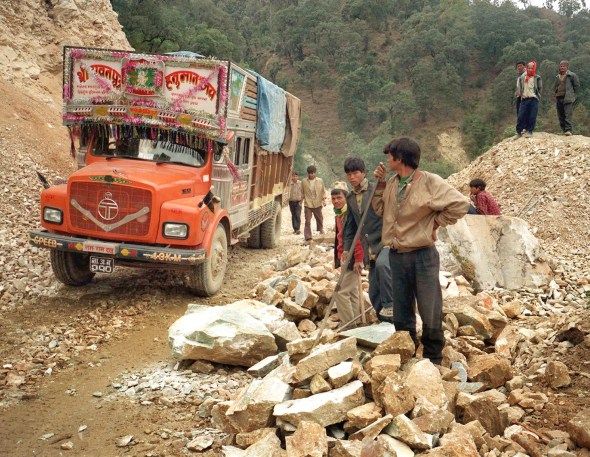 Before the roads were cut, if you want anything in or out of Annapurna you had to carry it or pay for it to be hauled in now locals are glad to see the progress. In 1997 a hundred years from the first white man’s visit to Nepal, I showed up and hiked up to Ghangdruk, three days in and two nights out, our expedition’s half-dozen camp boys, swelled to 28 sherpas, to carry provisions and camping gear. It was so neat, no roads, just a well worn trail! The same trail mankind had used since day one. Your feet leaving footprints where half of humanity have crossed over this mountainous trail. “HERE I AM FAR FROM HOME!” sang our camp boys around their warming fire. “NO ONE MISSES ME, I AM ALL ALONE.” NO SWEATHEART, MOTHER OR LOVED ONES…ALL ALONE!” they all sing delighted to have a job, with money coming in and sitting next to a warm fire. One of them would stay up all night with a Gurka knife watching over our tents and the entire camp, Germans the week before, had been robbed while eating dinner when someone with a knife slit their tents and helped themselves.
Before the roads were cut, if you want anything in or out of Annapurna you had to carry it or pay for it to be hauled in now locals are glad to see the progress. In 1997 a hundred years from the first white man’s visit to Nepal, I showed up and hiked up to Ghangdruk, three days in and two nights out, our expedition’s half-dozen camp boys, swelled to 28 sherpas, to carry provisions and camping gear. It was so neat, no roads, just a well worn trail! The same trail mankind had used since day one. Your feet leaving footprints where half of humanity have crossed over this mountainous trail. “HERE I AM FAR FROM HOME!” sang our camp boys around their warming fire. “NO ONE MISSES ME, I AM ALL ALONE.” NO SWEATHEART, MOTHER OR LOVED ONES…ALL ALONE!” they all sing delighted to have a job, with money coming in and sitting next to a warm fire. One of them would stay up all night with a Gurka knife watching over our tents and the entire camp, Germans the week before, had been robbed while eating dinner when someone with a knife slit their tents and helped themselves.  I remember the trail was often choked by donkey caravans each carrying two twenty gallon containers of kerosene for the generators, heaters, machinery and for light after the sun sinks. They took over the trail and you hugged the inner wall, each donkey following the tail of the one in front, who seemed to know the trail. Today the people of Annapurna would like to let the 21st Century in and benefit from the outside world with the ease of modern conveniences. Trip leaders and the famous sherpas fear the road will be the end to their profitable business of taking tourists into the wilds of Nepal. If there is a bus stop then who needs a guide!
I remember the trail was often choked by donkey caravans each carrying two twenty gallon containers of kerosene for the generators, heaters, machinery and for light after the sun sinks. They took over the trail and you hugged the inner wall, each donkey following the tail of the one in front, who seemed to know the trail. Today the people of Annapurna would like to let the 21st Century in and benefit from the outside world with the ease of modern conveniences. Trip leaders and the famous sherpas fear the road will be the end to their profitable business of taking tourists into the wilds of Nepal. If there is a bus stop then who needs a guide! 
 We encounter a new Tea House under construction beside the age old Annapurna route this tourism entrepreneur was building a six room hotel by shaping rock and cementing it one rock at a time, just like his ancestors centuries ago, The older man’s young wife, less than 20 years of age, the Tibetan refugee had a beautiful young child whose future looked bright. Work had began four weeks earlier on the hotel and he believed he would have it complete and ready to take boarders in another two weeks.
We encounter a new Tea House under construction beside the age old Annapurna route this tourism entrepreneur was building a six room hotel by shaping rock and cementing it one rock at a time, just like his ancestors centuries ago, The older man’s young wife, less than 20 years of age, the Tibetan refugee had a beautiful young child whose future looked bright. Work had began four weeks earlier on the hotel and he believed he would have it complete and ready to take boarders in another two weeks. 
 Eventually we will climb to 2000 meters to Ghangdruk on our third day of trekking, there at the cities edge we would be greeted by Nepalese Police who required we check-in (filling out some forms and flashing our Trekking Permits) before we could find our lodge where we would pitch our tents beneath the huge Fishtail formation known as Machhapuchre at a 22956 feet. The next morning I would arise early and walk the pathways through the community, enjoying meeting the residents-making some pictures and eventually being adopted by three boys who wanted to show me the basement of their large urban home. I followed them into the pitch dark room where after my eyes adjusted, I could barely make out a drum and some wall drawings and so I mounted my Nikon flash and made a photo. Since those were the good old film days, I didn’t see it was a ceremonial room for Hindu celebrations until I got home and got all my film developed and edited down.
Eventually we will climb to 2000 meters to Ghangdruk on our third day of trekking, there at the cities edge we would be greeted by Nepalese Police who required we check-in (filling out some forms and flashing our Trekking Permits) before we could find our lodge where we would pitch our tents beneath the huge Fishtail formation known as Machhapuchre at a 22956 feet. The next morning I would arise early and walk the pathways through the community, enjoying meeting the residents-making some pictures and eventually being adopted by three boys who wanted to show me the basement of their large urban home. I followed them into the pitch dark room where after my eyes adjusted, I could barely make out a drum and some wall drawings and so I mounted my Nikon flash and made a photo. Since those were the good old film days, I didn’t see it was a ceremonial room for Hindu celebrations until I got home and got all my film developed and edited down.
I soon found myself following kids in uniform heading to town for their school which held class outdoors right next to the main downtown businesses which consisted of tea shops and fruit stands. Everyone was very friendly, particularly the kids most who learn English in school and then chase down Western visitors to practice on. The people are a lot of fun and very curious where ever we went and set up camp, the locals would turn out like the circus had just arrived and watch. The return trek was the best because it was downhill and after a couple nights we returned to Pokhara which had been knocked off the grid by a thunderstorm. Everything was dark except car and truck lights and the amazingly light-up SHIVA murals flashing on the passing buses or Tata trucks which reflected in the standing water puddles. According to Hindu tradition, Shiva was once married to Sati and who would not be consoled after she died. The distraught widower never wanted to marry again. However, a young women named Parvati “Daughter of the Mountain” committed herself to living an austere life of meditation to win over Shiva. She meditated in the Himalayas for years, through driving rain, blistering heat, or elephant stampedes. But one day, she heard a child cry in suffering and she immediately sprang up to help. But it was Shiva, testing her resolve. She had failed his test, but he was so touched that she would give up what she desired most to help someone in need that he took Parvati as his wife who according to some actually his former wife, Sati in another life.  The Annapurna Sanctuary, a breathtaking high country tabernacle set in a circle of snow-capped mountains, won’t ever have the intrusion of a road. Settlements after the village of Chomrong were especially built for trekkers to whom a jeep or bus ride into the amphitheater’s over 13,000 feet would be profane. This open-sky, inner shrine, offers nearly 360 degrees of the surrounding Himalayan goddesses.
The Annapurna Sanctuary, a breathtaking high country tabernacle set in a circle of snow-capped mountains, won’t ever have the intrusion of a road. Settlements after the village of Chomrong were especially built for trekkers to whom a jeep or bus ride into the amphitheater’s over 13,000 feet would be profane. This open-sky, inner shrine, offers nearly 360 degrees of the surrounding Himalayan goddesses.  Nepal has been rebuilding its public image after a decade of Mao Communist storming the countryside, kidnapping, stealing and killing off enemies of their movement, particularly the Nepalese Army who police the remote spots on their landscape. The past two years, with the death of 16 climbers dying while climbing Everest in 2013 and now news of more than 43 dead, 175 injured, more than 40 people still reported missing after 6 feet of snow fell on the mountain in 12 hours unexpectedly closing the trail during the peak of trekking season. More than 500 trekkers have been rescued from the snow which fell in the Manang region, and it is damning news for a country trying to build their credibility as a safe outdoor adventure land. A story from the British Telegraph now blames eight deaths on a Tea House owner who threw out trekkers seeking shelter from the storm and offered to lead them to safety for cash, then abandoned them, leaving them to die, tough story to build up the business with. Big snows in the Nepalese high country is not unusual, usually the worst of it means there is no place to sleep and the price of tea goes through the roof after being trapped for a couple of weeks, on the Himalaya 10th highest peak, especially when the helicopters can’t fly. Like 2014, in 1995 more than 700 people died when residents and trekkers without the needed gear died of exposure, but worse yet, two avalanches took out two tea houses where trekkers had hold up for protection from the storm.
Nepal has been rebuilding its public image after a decade of Mao Communist storming the countryside, kidnapping, stealing and killing off enemies of their movement, particularly the Nepalese Army who police the remote spots on their landscape. The past two years, with the death of 16 climbers dying while climbing Everest in 2013 and now news of more than 43 dead, 175 injured, more than 40 people still reported missing after 6 feet of snow fell on the mountain in 12 hours unexpectedly closing the trail during the peak of trekking season. More than 500 trekkers have been rescued from the snow which fell in the Manang region, and it is damning news for a country trying to build their credibility as a safe outdoor adventure land. A story from the British Telegraph now blames eight deaths on a Tea House owner who threw out trekkers seeking shelter from the storm and offered to lead them to safety for cash, then abandoned them, leaving them to die, tough story to build up the business with. Big snows in the Nepalese high country is not unusual, usually the worst of it means there is no place to sleep and the price of tea goes through the roof after being trapped for a couple of weeks, on the Himalaya 10th highest peak, especially when the helicopters can’t fly. Like 2014, in 1995 more than 700 people died when residents and trekkers without the needed gear died of exposure, but worse yet, two avalanches took out two tea houses where trekkers had hold up for protection from the storm. 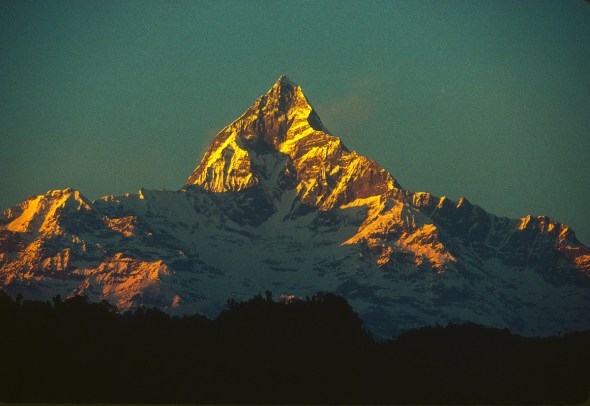
 Heavy snow had fallen in the high Himalaya when my trekking trip kicked off and we changed routes starting beside the beautiful reflecting lake near Pokhara. We refocused on the Annapurna Ghangdruk trek which is still popular among those trekkers who love soft and few days walking. Ghangdruk circuit trekking is a short trek in Nepal, the major highlight of Ghangdruk trekking is Ghangdruk village situated at an altitude of 2012 meters above sea level. Ghangdruk is inhabited by Gurung people, they are one of the major ethnic groups of Nepal having their own traditions and culture. Trekking there offers an excellent view of Annapurna South, Machhapuchhre and Himalchuli. Walking through rhododendron forests is another experience of this trek and the villages of Landruk, Dhampus gives a nice snapshot of rural lifestyle of Annapurna. THE ANNAPURNA CIRCUIT
Heavy snow had fallen in the high Himalaya when my trekking trip kicked off and we changed routes starting beside the beautiful reflecting lake near Pokhara. We refocused on the Annapurna Ghangdruk trek which is still popular among those trekkers who love soft and few days walking. Ghangdruk circuit trekking is a short trek in Nepal, the major highlight of Ghangdruk trekking is Ghangdruk village situated at an altitude of 2012 meters above sea level. Ghangdruk is inhabited by Gurung people, they are one of the major ethnic groups of Nepal having their own traditions and culture. Trekking there offers an excellent view of Annapurna South, Machhapuchhre and Himalchuli. Walking through rhododendron forests is another experience of this trek and the villages of Landruk, Dhampus gives a nice snapshot of rural lifestyle of Annapurna. THE ANNAPURNA CIRCUIT 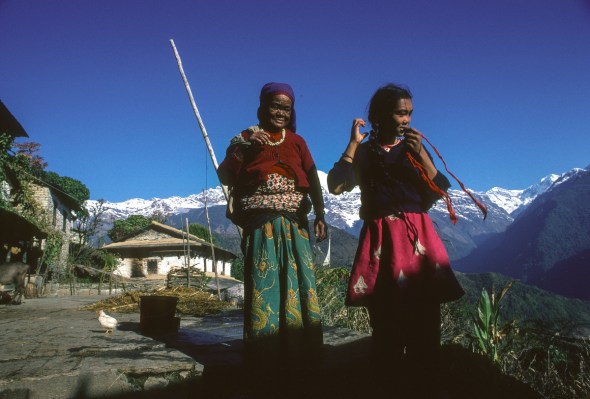 Trekking began in NEPAL in the 1950s. The role the Gurkha soldiers played in the British Army was very much appreciated so they promoted the Annapurna Region with the British. Before that, the famous Japanese monk and explorer Ekai Kawaguchi is considered to be the first tourist who visited the Mustang of Annapurna Region in 1899 while on his way to Tibet Girls I met on my visit on a viewpoint beg off photos because of modesty. These pretty middle class young women are close to the age to marry and must be modest. If they like a boy they would give him a picture. But if their picture was seen elsewhere–their virtue or character would be in question and their boyfriend might dump them.
Trekking began in NEPAL in the 1950s. The role the Gurkha soldiers played in the British Army was very much appreciated so they promoted the Annapurna Region with the British. Before that, the famous Japanese monk and explorer Ekai Kawaguchi is considered to be the first tourist who visited the Mustang of Annapurna Region in 1899 while on his way to Tibet Girls I met on my visit on a viewpoint beg off photos because of modesty. These pretty middle class young women are close to the age to marry and must be modest. If they like a boy they would give him a picture. But if their picture was seen elsewhere–their virtue or character would be in question and their boyfriend might dump them.  Tourism entrepreneurs in the Annapurna Region have suggested new trekking routes will be explored to avoid the threat of road extension and Tourism officer Anu Kumari Lama says new routes will be built. The new road, she says, is an opportunity to bring both conservation and development forward on a parallel track. The main Annapurna circuit starts from Lamjung and ends in Kaski. However there are dozens of other long and shorter trekking routes throughout the area.
Tourism entrepreneurs in the Annapurna Region have suggested new trekking routes will be explored to avoid the threat of road extension and Tourism officer Anu Kumari Lama says new routes will be built. The new road, she says, is an opportunity to bring both conservation and development forward on a parallel track. The main Annapurna circuit starts from Lamjung and ends in Kaski. However there are dozens of other long and shorter trekking routes throughout the area.  NEW ANNAPURNA ROAD THREATENS NEPALS TREKKING INDUSTRY All the treks feature scenic mountain views and cultural diversity, flora and fauna are the major attractions within the region. According to the Annapurna Conservation District there are 1226 species of plants, 102 mammals, 474 birds, 39 reptiles and 22 amphibians within Annapurna. One of the world’s largest rhododendron forests is in Myagdi, the world’s deepest gorge (22857 feet) is at Kaligandki, Tilicho Lake, the highest lake in the world (16138 feet), is in Manang and where there is an abundance of hot water springs.
NEW ANNAPURNA ROAD THREATENS NEPALS TREKKING INDUSTRY All the treks feature scenic mountain views and cultural diversity, flora and fauna are the major attractions within the region. According to the Annapurna Conservation District there are 1226 species of plants, 102 mammals, 474 birds, 39 reptiles and 22 amphibians within Annapurna. One of the world’s largest rhododendron forests is in Myagdi, the world’s deepest gorge (22857 feet) is at Kaligandki, Tilicho Lake, the highest lake in the world (16138 feet), is in Manang and where there is an abundance of hot water springs.  Additionally, beautiful mountains like Annapurna I (26545 feet), Dhaulagiri (26794 feet), above photo Machhapuchre a.k.a. Fishtail (22956 feet), the famous Muktinath Temple, decades old monasteries in Mustang and Mustangi King Jigmi Palbar Bista’s palace in Lo-Manthang of Upper Mustang are also attractions in upper Annapurna.
Additionally, beautiful mountains like Annapurna I (26545 feet), Dhaulagiri (26794 feet), above photo Machhapuchre a.k.a. Fishtail (22956 feet), the famous Muktinath Temple, decades old monasteries in Mustang and Mustangi King Jigmi Palbar Bista’s palace in Lo-Manthang of Upper Mustang are also attractions in upper Annapurna. 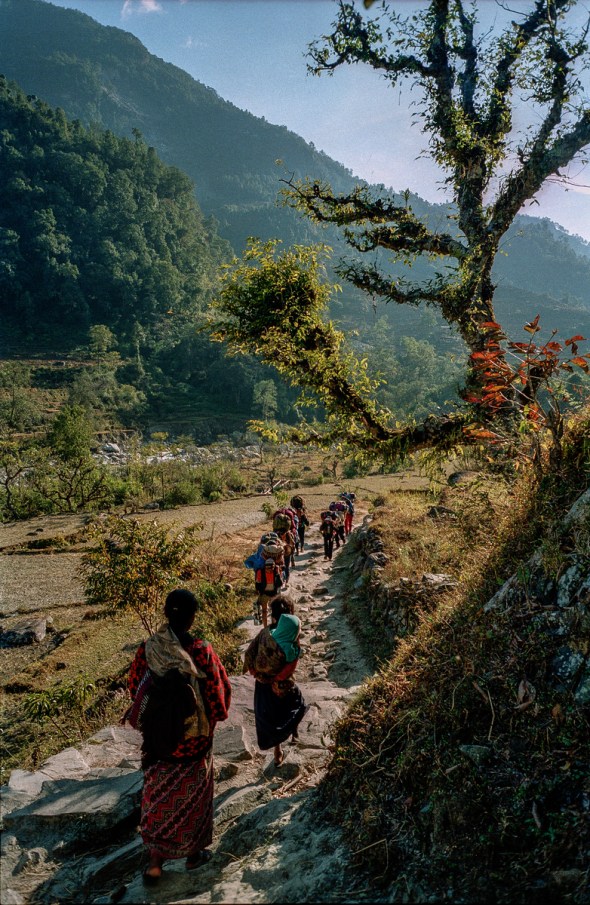 Nepal has a population of 18 million made up of different races and tribes living in different regions each with their own language. The rural Nepalese live much as they did centuries ago.
Nepal has a population of 18 million made up of different races and tribes living in different regions each with their own language. The rural Nepalese live much as they did centuries ago. “NAMASTE !” Is a form of greeting commonly found among Hindus of South Asia, Namaste is spoken with a slight bow and hands pressed together, palms touching and fingers pointing upwards, thumbs close to the chest. This gesture means “I bow to the divine in you. CLICK HERE FOR MORE PHOTOS…SEE SOUTHWESTPHOTOBANK.COM NEPAL GALLERY… CLICK HERE FOR MORE VIEWS OF TREKING IN ANNAPURNA…..
“NAMASTE !” Is a form of greeting commonly found among Hindus of South Asia, Namaste is spoken with a slight bow and hands pressed together, palms touching and fingers pointing upwards, thumbs close to the chest. This gesture means “I bow to the divine in you. CLICK HERE FOR MORE PHOTOS…SEE SOUTHWESTPHOTOBANK.COM NEPAL GALLERY… CLICK HERE FOR MORE VIEWS OF TREKING IN ANNAPURNA…..
<a href=" SPANISH TRANSLATIONS:




















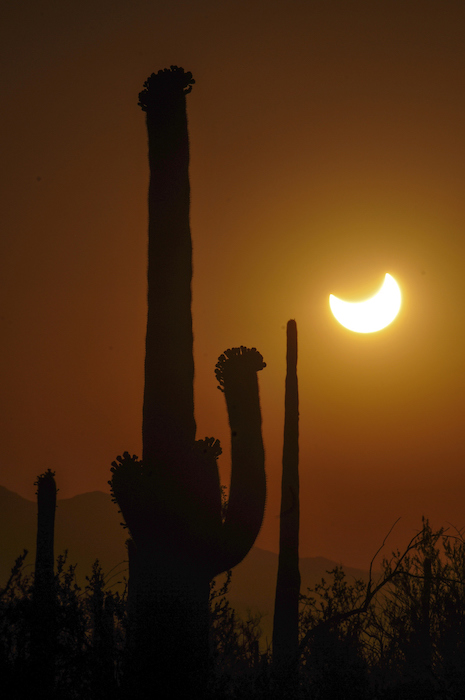





Leave a comment